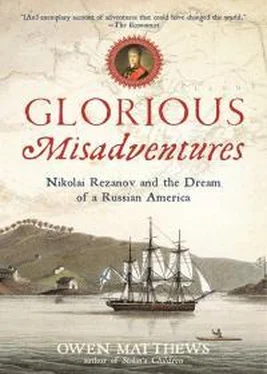The Empress considered the abolition of serfdom and attempted to canvas ideas internationally for reforming Russia. In 1766, at the behest of the palace, the Free Economic Society of St Petersburg sponsored a Europe-wide essay competition, offering cash prizes for the best answer to the question ‘What is useful to society, that the peasant should own land or only movable property, and how far should his right over one or the other extend?’ There were 164 anonymous entries, only seven of them in Russian. Voltaire submitted two, one in French and the other in Latin.*
However, the anarchic violence of Pugachev’s revolt in 1773-4 dampened Catherine’s reforming enthusiasms and put off attempts to end serfdom for nearly a century.13 The American Revolution and the rise of Jacobinism in France further steeled her against constitutionalism. But Catherine’s determination to bring Russia kicking and screaming into the eighteenth century by enlightened despotism rather than democracy continued unabated. For twenty years she conducted a semi-public correspondence with Voltaire. The old sage was delighted to be an unofficial adviser to the Empress and called his Russian penfriend the ‘Semiramis of the North’ after the great law-giving Assyrian queen.
Catherine also invited the Encyclopediste Denis Diderot to St Petersburg. Their daily talks became so animated that the Empress was forced to place a table between them to stop the Frenchman from grabbing her knees in his enthusiasm. In 1765 she had bought the impoverished Diderot’s library and made him its salaried librarian for life. Like her correspondence with Voltaire, the purchase was partly driven by private intellectual curiosity and partly by a calculated public display of cultural diplomacy. The acquisition of the library was Catherine’s grand reproach to a French society which had failed to support his genius. ‘Would you ever have suspected fifty years ago that one day the Scythians would so nobly recompense in Paris the virtue, science, and philosophy that are treated so shamefully among us?’ wrote Voltaire.14
In 1779 Catherine caused a similar sensation when she bought the art collection amassed by former British Prime Minister Robert Walpole from his spendthrift grandson. Its 204 pieces included works by Rembrandt, Rubens, Van Dyck, Hals and Guido Reni, and was probably the greatest single art purchase of the eighteenth century. It formed the basis of a new public museum attached to the Winter Palace that Catherine called the Hermitage. The English public was indignant, and the export of the Walpole collection became a national scandal. ‘How sad it is to see passing into the hands of Scythians things that are so precious that ten people at most will admire them in Russia,’ wrote the French collector and art dealer Jean-Henri Eberts of an earlier purchase of Catherine’s in September 1769.15 It was not the last time that Russian money would buy great British institutions, to the titillated disapproval of London’s chattering classes.
‘You forget that we are in different positions – you work with paper which forgives all while I, the poor Empress, must work with human hide,’ Catherine had written to Diderot after his departure from St Petersburg in 1774. That human hide had proved, by the late 1780s, less tractable than she had once imagined. By the time young Rezanov came to the capital to make his way in the world, the gulf between the Enlightenment enthusiasms of Catherine’s early reign and the reality of the absolute personal power of the Russian monarch was clearly apparent.
Like the Empress Elizabeth before her, Catherine added a twist to the traditional carousel of patronage and vying for place: the possibility of gaining the heights of power via the imperial bed. This practice is probably the part of Catherine’s life and world most misunderstood today. Catherine was a passionate woman lonely at the pinnacle of power she had seized for herself. She had been brought to Russia as a fourteen-year-old and married to the future Peter III, a psychologically crippled adolescent who preferred to play with toy soldiers rather than make love to his young wife.16 By her own account, in a startling frank autobiography that was banned by her son Paul, Peter did not touch her for the first nine years of their marriage. When he finally did perform his marital duty, Catherine’s three children were taken from her almost immediately and looked after by her domineering mother-in-law, the Empress Elizabeth. Small wonder that in later life Catherine’s relationships with both her children and her lovers were complicated by her emotional neediness and by the fact that her absolute power made a truly equal relationship impossible. ‘The trouble is that my heart is loath to be without love for even a single hour. If you want to keep me for ever then show me as much friendship as love and, more than anything else, love me and tell me the truth,’ she wrote to her greatest favourite of all, Grigory Potemkin.
In all, Catherine had twelve lovers during her life. She had long, passionate and faithful relationships with great men such as Grigory Orlov, the man who had helped her depose her husband, with Stanislaus Poniatowski, the brilliant Polish magnate whom she would elevate to the kingship of his native land, and with Potemkin. The rest of her lovers were found, loved and fired with a rather Germanic no-nonsense briskness. Candidates were checked for signs of venereal disease by the Empress’s Scottish physician Dr John Rogerson, and her lady-in-waiting the Countess Bruce would chat to them to assess their suitability as conversationalists, sending Catherine little notes with her conclusions.17
Prince Grigory Potemkin was the Empress’s longest-serving favourite. He was also for a time virtual co-ruler of Russia. He caught her eye as a dashing young sergeant on the very day of her coup against Peter III. According to his own later account, Catherine was reviewing her troops in full (male) guards uniform in preparation for a march on the Palace of Peterhof, but lacked a sword knot. Impertinently, Potemkin rode out of the line to offer her his own, which was graciously accepted. He was subsequently rewarded with an officer’s commission and the favour of the Empress. He persisted in his gallantry, and meanwhile rose to major-general and covered himself in glory in Catherine’s wars against the Turks. Finally in February 1774 his persistence was rewarded and he became Catherine’s lover – but not before he had threatened to retreat to a monastery in a fit of amorous anguish.
Their relationship was tempestuous. Catherine was frequently exasperated by Potemkin’s tantrums and fits of jealousy, but she recognized that he was ‘one of the great originals of the age’. Part of her was clearly happy to have found a man who was her match in terms of energy and intellect. In December 1774 Catherine privately referred to Potemkin as her ‘husband’ for the first time and continued to do so in twenty-two letters between 1774 and 1791. To marry officially would have been politically and dynastically complicated for Catherine, who despite her late husband’s inadequacies had at least produced a legitimate heir, the future Paul I. But it is probable that Potemkin became her consort, at least secretly.18
Catherine showered Potemkin with wealth and titles, including that of prince of the Holy Roman Empire ( Reichsfürst ), and remained devoted to him until the end of her life. But their physical relations probably ended soon after Catherine took one of her secretaries, Pyotr Zavadovsky, as a new lover in 1776. Potemkin himself was spectacularly unfaithful, taking at least one of his nieces to his bed. But they remained close and affectionate allies, and despite his lingering jealousy Potemkin had to tolerate Catherine’s taking a succession of young lovers.
Читать дальше












